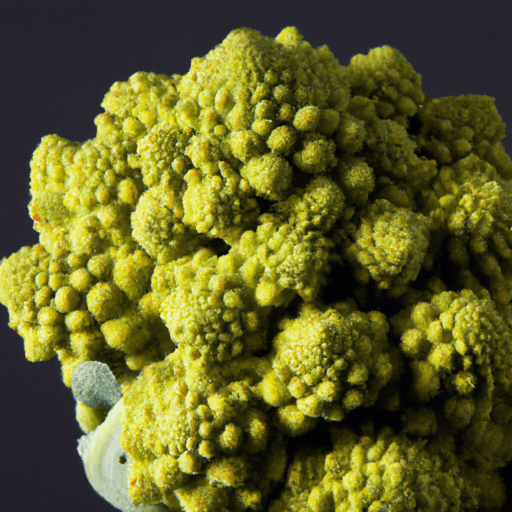Discovering Romanesco Broccoli: A Wonder of Nature’s Geometry
Romanesco broccoli, also known as Roman cauliflower or Romanesque cauliflower, is a mesmerizing vegetable that captivates with its striking appearance and delicate flavor. Its unique fractal pattern, consisting of symmetric spirals and intricate cone-like formations, resembles a natural work of art. In this blog post, we’ll delve into the culinary world of romanesco broccoli, exploring its taste, cooking uses, nutritional value, and some intriguing historical and factual tidbits.
A Captivating Flavor Profile
The taste of romanesco broccoli is often described as a blend of cauliflower and broccoli with a slightly nutty undertone. It boasts a mild, earthy flavor that is less bitter than regular broccoli, making it a versatile ingredient to work with. Its subtle taste adds a delightful twist to various dishes, making it an excellent alternative to traditional broccoli or cauliflower.
Culinary Delights with Romanesco Broccoli
Romanesco broccoli’s unique appearance and delicate flavor make it a perfect addition to both raw and cooked dishes. Here are some exciting ways to incorporate this vibrant vegetable into your culinary repertoire:
Roasted Romanesco Medley
Combine romanesco florets with other colorful vegetables such as carrots, bell peppers, and purple potatoes. Toss them in olive oil, sprinkle with your favorite herbs and spices, and roast them in the oven until they acquire a beautiful golden-brown color. This simple yet visually stunning dish will surely impress both your guests and taste buds.
Romanesco Salad
Blanch romanesco florets in salted water until they turn vibrant green and retain their crispness. Toss them with a light vinaigrette dressing, toasted pine nuts, and crumbled feta cheese. The salad’s harmonious blend of textures and flavors will make an excellent addition to any meal.
Romanesco Pasta
Sauté romanesco florets with garlic and red pepper flakes in olive oil until they become tender. Toss the cooked florets with your favorite pasta, grated Parmesan cheese, and a squeeze of lemon juice. This quick and satisfying pasta dish celebrates the delicate flavor of romanesco broccoli while creating a vibrant, visually appealing plate.
A Nutritional Powerhouse
Romanesco broccoli is not only visually captivating and delicious but also a nutritional powerhouse. Packed with essential vitamins and minerals, it not only enhances the flavor of your meals but also offers numerous health benefits. Here are some key nutrients found in this delightful vegetable:
Vitamin C: Romanesco broccoli is rich in vitamin C, which plays a crucial role in immune function and collagen production.
Vitamin K: This vegetable is an excellent source of vitamin K, essential for blood clotting and bone health.
Fiber: With its high fiber content, romanesco broccoli contributes to a healthy digestive system and can help in maintaining a balanced diet.
Fun Facts and Historical Tidbits
Romanesco broccoli belongs to the Brassica oleracea family, which also includes cabbage, broccoli, cauliflower, and kale.
It is believed that romanesco broccoli originated in Italy, particularly in Rome’s surrounding regions, which is how it acquired its name.
The striking fractal patterns in romanesco broccoli are not purely decorative; they follow the Fibonacci sequence, a mathematical pattern that often occurs in nature.
Romanesco broccoli gained popularity in recent years due to its appearances in pop culture, including its use as a representation of a “fractal” or “geeky” vegetable.
With its captivating appearance, delicate flavor, and remarkable nutritional value, romanesco broccoli is unquestionably a star in the world of vegetables. Its versatility in the kitchen allows you to get creative and infuse your dishes with both beauty and flavor. So next time you come across this wonder of nature’s geometry, don’t hesitate to bring it into your culinary adventures and showcase its unique attributes to your family and friends.
Origin:
- Romanesco broccoli, also known as Roman cauliflower or Romanesco cabbage, is a cultivar of Brassica oleracea, which also includes broccoli, cauliflower, and Brussels sprouts.
- It is believed to have originated in the Mediterranean region, specifically in Italy.
Common Uses:
- Romanesco broccoli can be used in various culinary applications, including raw consumption, sautéing, roasting, and steaming.
- It can be served as a side dish, added to salads or pasta dishes, or used in stir-fries and gratins.
Nutritional Benefits:
- Romanesco broccoli is an excellent source of fiber, vitamin C, vitamin K, and folate.
- It also contains minerals such as potassium, calcium, and magnesium.
- It is low in calories and rich in antioxidants.
Unique Properties:
- Romanesco broccoli stands out for its unique appearance, with a striking fractal-like pattern formed by its spiraling florets.
- It has a milder, nuttier flavor compared to regular cauliflower or broccoli.
- This vegetable tends to retain its firm texture even after cooking, making it suitable for various dishes.
Historical Significance:
- Romanesco broccoli has been cultivated in Italy since the 16th century.
- It is often associated with Italian cuisine, particularly in recipes from the region of Lazio, where it is commonly used.
- In recent years, Romanesco broccoli has gained popularity worldwide and is now grown in various countries.




Use the share button below if you liked it.
It makes me smile, when I see it.